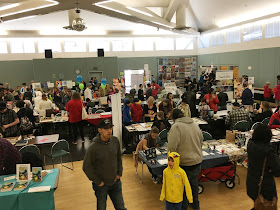I haven't done a "how to" post in a long time, but a few days ago I made a drawing that I was uncharacteristically happy with, and thought it'd be a good example of how I sometimes combine real ink-on-paper art with digital (Photoshop) manipulation to get the result I want.
As always, this isn't the right way or the only way, it's just one way I solved a particular problem. Your mileage may vary.
I think it helps to have some sort of Philosophy of Art, even if you don't call it that--some sense of how you like to do things. A Platonic Ideal. For example, my ideal comic would be one that's entirely hand drawn, hand lettered, and even hand colored right on the page. A comic crafted like that has integrity.
Now, I don't ever do that. For production and printing purposes, I letter and color in Photoshop. But I know some people who do, such as the great Carol Tyler. What you see in her books is exactly what she puts on the paper. I admire and envy that authenticity, and consider everything I do that
isn't that a compromise that comes with a cost.
Your goal guides your process. I think Art should be as organic and analog as possible. Other artists have different philosophies. Many don't hesitate to do as much digital work as they can, up to 100 percent. I won't argue. It can look terrific. Whatever works. As the great cartoonist Wally Wood said:
Never draw what you can swipe.
Never swipe what you can trace.
Never trace what you can cut out and paste.
And never do any of that if you can hire somebody to do it for you.
One reason I'm happy with this drawing, which is for a future project I won't talk about that's set to follow
another project I won't talk about, is that it took me several tries to crack it. I couldn't figure out my composition and point of view. Here's what I came up with:
Based on photos of a real place, it's a black-and-white two-page spread that'll be printed with the left half on one page and the right half on the facing page. I'm happy with it because the left page draws your eye to the word balloon and car, the right page draws your eye to its destination--the steps and doors behind the flagpole--and together they make an asymmetrical but balanced (I think) composition.
I did not want to spend two weeks drawing that. So I cheated.
First I drew this. You can see some of my blue penciling under my black ink lines:
Yeah, I drew all those rocks by hand; I'm not
completely lazy. I also drew this:
Those four rectangles at the top of the drawing became groups of three or four windows of various widths and heights simply by squashing or stretching them in Photoshop:
Copy and paste and paste and paste and paste and paste:
Copy and paste that whole thing five times and BOOM, instant sprawling compound.
I drew the car separately because
I don't like to draw cars:
One thing I kept in mind when drawing the car, and throughout the entire assembly, was keeping line weight consistent for the final drawing. I drew the car with a thicker line and less detail than I otherwise might have because I knew it would end up very small, and it still had to look like it belonged in the rest of the picture.
I didn't draw all the trees. I actually really love inking pine trees with a brush--it's meditative--but not that many. Instead, I drew 20 trees and clumps of trees, then manipulated them to look like more. Copy and paste those variations, trying not to put two duplicates next to each other, and you've got a forest.
 |
| The top row are the only trees I actually drew. The rest I tweaked in Photoshop. |
So here are the buildings and car pieced together, followed by the trees on a separate Photoshop layer (think of it as a transparency), which makes it a lot easier to color the ground "behind" them:
Put 'em all together, add some grays and words, and easy-peasy.
I don't expect to rely on so much digital tomfoolery for the rest of the project. I still aim to render as much by hand as possible. But because this two-page spread is an important establishing shot that shows the reader where they are and sets the stage for the entire story, I needed this level of detail and grand scale. After laying that foundation, I can relax a bit.
Maybe someone else could do a drawing like that completely freehand but I can't, at least in the time I had to spend on it. So I did what works, with no apologies. It looks exactly like I wanted it to.
That's the goal that guided my process.

























